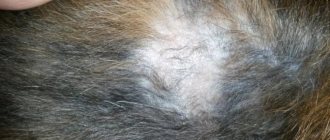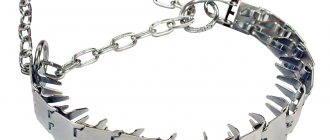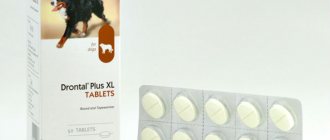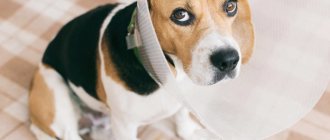What is this
Animal hair is significantly different from the hair that grows on the human body. Of course, each dog breed has its own unique hair characteristics. But they all have one thing in common - the cyclical nature of hair growth and loss. A dog's fur does not grow continuously. After the so-called rest period, the dog begins to rapidly grow hair. After some time, this fur dies and is shed. Moreover, during molting, almost all the hair on the animal’s body is renewed.
After this, the hair begins a new cycle - it begins to grow again. This period lasts on average 130-140 days .
The onset and duration of shedding depends on whether the dog is in its native climate. For example, a husky living in the north never sheds sharply, but changes its hair coat constantly throughout the year. A dog of the same breed living in the central zone sheds its hair like other dogs - twice a year.
Dog fur is divided into three types:
- Tactile is a mustache, eyebrows and short hairs in the ears.
- The guard coat is a hard coat that provides protection from moisture, parasites and serves to camouflage the animal.
- Undercoat - helps maintain proper body temperature, protects from cold and moisture.
Depending on the temperature outside the window, a more intensive renewal of one of them occurs.
Normally, dogs shed in spring and early fall and last one to two weeks. But there are a number of additions to this rule:
- Long-haired dogs (for example, breeds such as Afghan Hound, South Russian Shepherd) need brushing all year round, regardless of the season. Their outer layer of fur changes continuously.
- Bitches begin to shed unexpectedly during the period of estrus. Usually it is shorter lasting, but quite intense.
- Typically, females shed more than males.
- A dog may shed a lot if it suddenly moves to a hot climate.
- In dogs with thick undercoat, the shedding period can last up to 3-3.5 weeks. The fact is that first the dog sheds part of the outer layer, and only then the undercoat sheds.
There are also dogs that don't shed. It is important to purchase such dogs from experienced and trusted breeders, because this property is traceable by pedigree. But you shouldn’t expect that you will never find hair in the house - after all, occasionally, the hair of such dogs falls out. These breeds include: Poodle, Chinese Crested, Miniature Schnauzer, Giant Schnauzer, Fox Terrier, Airedale Terrier, Yorkshire Terrier, White, Scotch, Boston and Staffordshire Terriers, Brussels Griffon, Bichon Frize, Basenji.
Is it time to shed or when does it happen?
The very first coat changes by 1.5 months, and in some breeds the color of the coat also changes, becoming darker or, conversely, lighter.
The first age-related shedding in dogs begins no earlier than 6 months of age, during which the downy coat changes to a harder and denser one. In some pets, the fur takes several years to develop and becomes characteristic of adult animals only after several molts.
However, in some cases, the first age-related shedding in dogs can begin at 3.5-4 months, when the guard hair begins to grow. The process of hair change can last up to a year, and in some breeds up to 2 years.
Some breeds have a long and heavy shedding period, while other dogs shed all year round, shedding small amounts of hair daily. Pets typically shed twice a year.
- In autumn . Usually in September, the light summer coat is shed and a thick, warm undercoat is built up, the pet visually increases in volume, becomes softer and fluffier;
- At the end of spring . Usually in May, the undercoat falls out. Spring shedding in dogs lasts less time than autumn shedding.
The timing of shedding in dogs varies, with seasonal shedding lasting about 1-3 weeks. For pets living in an apartment, the timing of shedding may change, and instead of a seasonal change, hair loss occurs all year round due to constant air temperature.
In heated and artificially lit houses, the animal’s brain does not receive a signal that a coat change is required; the pets’ bodies are not exposed to natural temperatures, especially if the animals spend most of their time in the apartment and walk very little. The body does not notice the change of seasons and an abundant period of molting does not occur. As a result, shedding occurs on a constant basis every day in small quantities.
When does seasonality occur and its causes?
When does our wet noses begin to lose hair? A dog's coat is renewed twice a year. This is a natural and natural process, laid down genetically. After all, hair helps a pet adapt to weather conditions and feel comfortable when temperatures change.
When does the spring season start? In spring, the dog loses its thick, long coat – the outer layer. The undercoat becomes much thinner and softer. Spring shedding in dogs usually begins after the end of frost.
In autumn, the light coat of hair is replaced by a coarser one with a thick, dense undercoat - so that the dog does not freeze during cold weather.
Are there any special products against heavy shedding?
You can stop heavy shedding in dogs with the help of complex vitamins and nutritional supplements. If this does not help, then you need to contact a veterinarian, who, after an examination, will make a decision and tell you how to help the animal.
What is express molting, reviews and prices
REFERENCE! Express shedding is a professional combing performed by a master in a pet salon. It is especially effective during seasonal shedding, but it can also be performed at any time on animals that live indoors and shed year-round.
Of course, every owner in the house or in the yard can comb his dog, but not everyone knows how to do it correctly, they don’t know how to comb it correctly during shedding and how to handle the tool and the animal. The result of improper handling can be skin damage of varying degrees of complexity, torn hair and stress in the dog. In addition, not everyone has the time and desire to comb, or there may be another reason - someone in the family is allergic to dog hair. With express shedding performed by a professional, all this can be avoided.
How is express molting done? The master places the animal on the table and combs it with a furminator brush. Then the animal is bathed with shampoo and mask and the hair is dried with a special hairdryer. With these procedures, almost 90% of unnecessary fur is immediately removed, revealing a brand new shiny coat. Thanks to quick combing, the pet looks well-groomed and hair no longer lies all over the house, which, according to dog owners, is the main advantage of the procedure. The effect of express shedding lasts for 2–3 months. The price for this depends on the size of the dog, the thickness and length of its coat. Express shedding is not carried out at home; it is done only in specialized salons.
How long does it last
The average duration of molting is from 7 to 14 days. It all depends, firstly, on the breed of the pet. The longer and thicker the coat, the longer it will take to change the coat. Secondly, animals that live in an apartment or house all year round cease to react sharply to temperature changes. Therefore, their molting can continue all year, only slightly intensifying in spring and autumn.
The described process refers to natural or planned molting . It is impossible to avoid it or influence its speed, so during such periods it is important to help your pet by brushing it daily.
The condition of a dog's coat is an indicator of its health. Ideally, the coat should be smooth, silky and shiny. If you notice that every day your hair becomes duller, hair constantly falls out, bald spots appear or looks sloppy, immediately contact a specialist. The sooner you diagnose the cause of the illness, the sooner you can begin treatment.
Why does hair fall out in winter?
If any problems happen to the dog, the owner does not notice alarming symptoms until hair loss begins. What is hidden behind molting in winter and what to do?
Unfortunately, unscheduled winter shedding is a problem that most dog lovers face. If you notice that the animal is shedding, carefully analyze the previous month - were there any alarming symptoms? Maybe the dog was itching more than usual or was very lethargic and inactive.
Tip : A good way to stop shedding is to let your dog bathe in clean snow.
Reasons for early shedding in winter (for example, in February):
- Then carefully examine your pet's skin. If there is redness, you are probably dealing with dermatitis . It is easy to cure, but this should only be done under the supervision of a specialist.
- Often, your dog may react to shampoos or other detergents. Do you wash your dog more often than usual in winter?
- A lack of vitamins A and E, as well as fatty amino acids Omega-3 and Omega-6, significantly worsens the condition of dogs' hair, especially in winter and during the off-season. Be sure to take vitamin courses if you feed your dog dry food.
- Impaired body functions may be a reaction to the environment. An animal may react negatively to the reagent or salt that is sprinkled on sidewalks. Carefully examine your pet's paws - are there any wounds or ulcers on them? An unpleasant odor will also be a bad symptom.
- The cause may also be infection by parasites . Fleas or lice can appear on an animal even in winter. Inspect the fur, especially the ears, belly, and inner thighs. Look not only for the insects themselves, but also for traces of their vital activity - red dots from bites and larvae.
IMPORTANT: If you find a lice eater, be sure to take an additional anthelmintic. After all, lice eaters can carry worms.
When does the first one start?
At what age does hair loss first occur? Age-related shedding is a natural process that all dogs undergo at a certain age. The first shedding occurs at about two months (or less) - when puppy fluff is replaced by the first coat. This coat is usually a different color from that of a puppy. It can be a couple of shades darker or lighter. Teenage fur already resembles the fur of an adult animal in structure and properties.
The next molt occurs at approximately six months . From this point on, the dog's hair will gradually change, forming a denser and thicker layer. In some breeds of dogs (long-haired with a thick, dense coat), several molts must occur to completely get rid of teenage hair.
How to fight: express (artificial)
A so-called “express shedding” service for dogs is currently available. It is offered in almost every pet salon, although some owners carry out this procedure on their own at home.
Express shedding at home for dogs - how is it done? How to speed up shedding?
It consists of washing with a special product in very warm water. Then the mask is applied. The animal is covered with a film and a towel on top. This creates a sauna effect. Thanks to this, the pores open and all the hair ready for shedding is removed much faster.
The mask is washed off, and the coat is thoroughly combed, exposing the coat to hot air using a hairdryer. Express shedding removes almost 90% of shed hair.
IMPORTANT: This procedure is absolutely safe for the animal. But this service is not suitable for dogs that are not accustomed to bathing, brushing and blow-drying.
What is express shedding for dogs?
Grooming a miniature schnauzer: trimming at home
Forced shedding of unwanted hair in dogs is called express shedding. The names of the procedure will also be correct: steam bath or combing out the undercoat.
For very hairy breeds, this procedure is simply a salvation. If in nature the skin of wild animals becomes overgrown with hair depending on climatic conditions, then for pets only the desire of the owner matters.
Even divers and Alabais sometimes have to survive in warm living conditions. Express moulting is a necessity in such cases. It is often necessary to carry it out 2-3 times a year.
What to do if it is very strong?
The situation is completely different when unscheduled, prolonged or very intense molting begins. This may be a signal of either age-related changes or disruptions in the functioning of the animal’s body.
If you notice that your pet is shedding more or for longer than usual, the first step is to contact your veterinarian. It is better to immediately conduct an examination and, if necessary, get tested.
The most common causes of severe hair loss:
- Insufficient or unbalanced nutrition.
- Lack of vitamins and microelements.
- Dehydration.
- Immune disorders.
- Infestation with parasites.
- Hormonal imbalances.
- Diseases of the gastrointestinal tract, kidneys, liver.
- Endocrine disorders.
- Hepatitis.
- Severe stress (for example, due to moving or separation from the owner for a long time).
- Too frequent bathing using shampoos and other detergents.
- Allergies (to food, shampoos, environmental items, etc.).
To help your pet during periods of intense shedding, you need to brush it daily . This is easy to do with the help of various combs and brushes sold in pet stores. Select a brush that suits your coat type and carry out this procedure at least once a day.
This will not only get rid of hair on the floor and furniture, but will also significantly speed up the shedding process. The coat will renew itself faster and become silkier, because with the brush you are working on the dog’s skin layer, increasing the blood supply to the hair follicles.
IMPORTANT: Short-haired dogs, in addition to combing, must be wiped with a special terry towel. It should be tough to help the dog get rid of excess hair that the brush could not remove.
How to speed up and reduce?
It is impossible to completely stop the process of hair loss. But you can speed it up. This will help your pet recover as quickly as possible.
- An essential condition is daily combing of the coat.
- To speed up hair renewal, washing your dog in warm water using protein shampoo or a special product for animals during the molting period will help. After washing your pet, you need to wrap it in a towel for 1-2 hours. It is important to carefully monitor its condition to prevent overheating. Then the animal must be thoroughly combed. This will speed up the molting process, but you should not resort to this method too often.
- If you want to improve the condition of the coat, it is important your pet properly During this period, the dog spends a lot of energy on the formation of new hair. A complex of vitamins and a balanced diet will help the animal maintain health.
- You can add vegetable oils or fish oil at the rate of 1 teaspoon per 4.5 kg of body weight. Once a week you can give fillets of sea fish.
Mud fight: how often and with what can you wash your dog?
How to get rid of shedding
It is impossible to completely stop the process of hair loss, but regular care during seasonal shedding in dogs will help stop the uncontrolled spread of hair around the house.
An effective hair removal tool is the furminator, which can remove most dead hair in just one session, although the session can last up to an hour or more, depending on the size of the animal and the thickness of the undercoat.
To remove undercoat, you can use brushes, slicker brushes, rubber mittens, and other tools designed for this purpose, but it is not recommended to cut your pets' hair. After cutting, the undercoat will grow even thicker.
To speed up shedding, it is effective to wash your pet in warm water with protein shampoo or shampoo for shedding dogs, then wrap your pet in a warm blanket for 1-2 hours. It is important to monitor the animal's condition during this time, otherwise there is a risk of overheating. This method allows you to speed up shedding, which will take several days, but will be accompanied by heavy hair loss. However, washing the animal is often not recommended.
To reduce shedding in a dog, you need to feed your pet properly. A balanced diet is important, the basis of which should be meat, regardless of the type of feeding. Dry food and a natural diet should contain high-quality products rich in nutrients (vitamins, Omega-3 and Omega-6 fatty acids, antioxidants), which are necessary to maintain the health of the coat and skin, and the body as a whole. With natural feeding, it is useful to give the animal vitamins, but if the pet eats dry high-quality food, there is no need for additional vitamins.
Remedies and tablets from: what vitamins to give during?
Pharmaceutical companies offer a wide selection of vitamin and mineral complexes that help your pet quickly restore health and get rid of unplanned shedding.
It is important to understand what vitamins are necessary for skin and coat:
- Vitamin A is the main anti-shedding vitamin and is essential in the synthesis of collagen, elastane and keratin fibers. If there is not enough of it, the coat becomes dull and brittle. Vitamin A (or retinol) is an essential component of any complex for dog hair.
- Vitamin E - helps cope with the negative effects of the environment. It is also called "tocopherol". Tocopherol significantly reduces the amount of hair falling out.
- Vitamin C – helps improve blood circulation and nutrition of hair follicles. With a lack of this vitamin, the animal's hair becomes dry and brittle.
- B vitamins are indispensable in the treatment of skin diseases and malfunction of the sebaceous glands. It is important to use these vitamins not only during illness, but also for prevention.
- Vitamin PP or nicotinic acid has a beneficial effect on the level of pigmentation. The pet's coat will be bright and shiny.
- Fatty acids have already been mentioned above. Omega-3 and 6 help quickly renew hair. The wool becomes soft, elastic and shiny. With regular use of Omega, coat density approaches the optimal values for the breed.
- Zinc supports proper functioning of the thyroid gland.
- Sulfur not only helps to cope with seborrhea and hyperkeratosis, but also improves the functioning of the sebaceous glands.
- The combination of phosphorus and calcium is necessary to maintain the natural shine of the coat.
- Manganese is necessary for the synthesis of keratin.
- Copper allows collagen to form, which makes the coat soft and free from breakage.
Vitamin complexes and tablets offered by pharmaceutical companies include Yumega Boost, Virbac Megaderm, VitsCan and Safari Skin and Coat.
IMPORTANT: Before giving your pet medications or any vitamin complexes, consult your veterinarian.
Prevention
How to protect your beloved pet from unscheduled shedding? This question is often asked by dog owners. After all, you want your four-legged friend to always be cheerful and healthy. For this, constant care and attention is important.
- Routine visit to the veterinarian.
Often, only an experienced specialist can replace the disease in the early stages, which will allow your pet to be quickly cured.
- Systematic inspection of the animal's home.
It is important to check whether the animal has parasites and whether the condition of its skin, fur, teeth and gums is normal.
- Taking vitamins and proper nutrition.
Make sure that your pet eats regularly and only fresh food intended for its age and breed.
- Regular washing and combing of wool.
Still, you should not bathe your dog too often, but it is also undesirable to neglect hygiene.
- Peace.
Any stress causes irreparable damage to the animal’s psyche. Try to avoid this.
- Walks in the open air.
Walk your dog every day, even in bad weather. But be careful - do not allow the animal to overheat or hypothermia.
So, it is very important to monitor the condition of your pet and help him not only during periods of stress, but also to provide proper prevention. A dog is not only a source of joy, but also a great responsibility.
How to properly comb fur during shedding period
It doesn’t matter what caused the coat change - the onset of the season or other factors, but it is important to help the dog and alleviate its condition during this difficult period.
The main method is to comb the coat daily with a special comb or brush. This manipulation is extremely beneficial for the health of the animal, since:
- will help the dog get rid of dead hair and accelerate the growth of new hairs;
- will have a stimulating effect on blood circulation in the upper layer of the epidermis, which will improve the supply of nutrients, vitamins and beneficial microelements to the hair follicle;
- will improve the appearance of the coat - it will become smoother, silkier.
Also, if you brush your dog daily, you will have to use a broom or vacuum cleaner less often.
Such care also requires special tools:
- To remove tangles from the undercoat, you will need a comb made of hardened steel; it would be nice if it was coated with nickel.
- Where a metal tool is not suitable, a more delicate slicker brush will come in handy. Suitable for use in delicate areas.
- A glove-shaped brush is good at removing dead hair from a dog’s body.
Using this set of devices daily, you can rid your pet of old fur in 4-5 days. There is also a tool that can perform almost all of the above functions - the furminator. It looks like a rake and acts without damaging the new coat, hooking and lifting the undercoat layer.
There are restrictions on its use - it cannot be used if there is damage to the animal’s skin - irritated areas, ulcers, wounds, hematomas or abrasions. It is also not suitable for processing some breeds - friese, American spaniels, terriers, Chinese crested dogs, poodles, lap dogs, curly-haired retrievers.
Another important condition is that the dog should not have tangles, which means that before the procedure it is necessary to comb out the hair with a comb or a metal comb. If this is not done, the pet will be in too much pain.
You can quickly rid your beloved pet of dead hair by using a furminator after bathing. The tool should be moved along the growth of the fur, carefully and without pressure.
You can watch a video about proper brushing of a dog:
Photo
Master, comb me!
What are you watching? Clean it up!
Conclusion
- Shedding in dogs is divided into natural and unplanned.
- Natural molting occurs in the off-season, that is, in spring and early autumn.
- Unscheduled shedding can occur for natural reasons (estrus, stress, sudden climate change), or it can be an indicator of serious diseases.
- The dog begins to shed at the age of six months.
- It is important to brush your dog regularly to prevent matting.
- You can help your pet during this difficult period with the help of an express shedding service, proper diet and vitamin intake.
Surely each of you has your own secrets. What do you do during shedding? How do you deal with the amount of wool in the house? How is your dog feeling? Share information and, of course, a photo of your wonderful pet!
Natural shedding in dogs
A dog's coat performs a number of important functions:
- Makes the animal's skin inaccessible to various kinds of parasites - fleas, ticks.
- Prevents the development of infectious diseases.
- Protects from atmospheric agents.
In addition, a beautiful, shiny coat gives the dog a well-groomed appearance. The owner more often awakens the desire to stroke the pet’s luxurious fur coat, and this brings pleasure to both parties.
But wool has one property - it undergoes renewal 2 times a year. This is a very important process for the health of the animal, which occurs in spring and autumn.
A common question is: “How long does it take for dogs to shed?” The duration of natural molting is 7-14 days. During this period, it is necessary to take certain measures, and of course, you will have to clean the house more often, since it will not be possible to completely get rid of the ubiquitous wool. The first molt begins after they reach six months of age.











